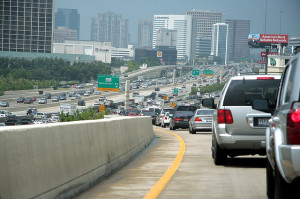Calm in Houston Traffic
The diverse sites, sounds, cultures, and entertainment make Houston a great city. Never a dull moment. But a big challenge in this ever-expanding city is the constant traffic. It is not uncommon for cars to cut in front, ride bumpers, or weave at a ferocious pace in and out of rows of vehicles on a busy freeway. It is also common to find oneself in the middle of a traffic jam.
These frequent occurrences can create a cloud of stress and agitation that floats over the rest of the day. How we take care of ourselves in the midst of this inevitable stress is a great predictor of how much space we will have to respond to others (and ourselves) with understanding and kindness as each day progresses.
We can practice calming ourselves, and allow the cloud of stress to dissipate when we accept the situation and learn to adapt. Traffic is not going away. How can we learn to cope so that our day goes more smoothly? Here are some ideas to experiment with during the next traffic episode:
1. Make a plan. A great place to start is to know that something stressful is likely to happen while on the road. We can put a plan into practice every time we are in a stressful situation. Take a moment and visualize being in traffic in the future, and create new ways to respond and remain calm.
2. Add more time. Many of us plan for the exact amount of time it should take to get to our destination. When we get caught in traffic, the stress and frustration begin to build when we realize that we might be late. We may end up feeling rushed and harried when we eventually arrive. This rushed feeling can stay with us for the rest of our day. If we can add five or ten minutes to our estimated traveling time, we give ourselves a break. We can use the time when we are stalled in traffic as an opportunity to listen to a favorite song, or simply to take a moment to pause. If there is no traffic, bonus! We get to arrive early and fresh.
3. Breathe. Deep breath connects us instantly to the calming mechanisms of our body. “As it turns out, deep breathing is not only relaxing, it’s been scientifically proven to affect the heart, the brain, digestion, and the immune system.” (Cuda, 2010) Placing a reminder to breathe on our dashboard can be a simple way to bring us back to our breath: This simple poem uses both breath and smiling as a way to soothe our frustration and bring the level of agitation down: “Breathing in, I calm body and mind. Breathing out, I smile. Dwelling in the present moment I know this is the only moment.” Thích Nhất Hạnh
4. Make a mental gratitude list. When we think consciously about all of the good things in our day, our mood shifts. A regular gratitude practice increases levels of happiness and contentment. In his TED talk, Shawn Achor, researcher at Harvard University, reported that “Ninety percent of your happiness is not predicted by your external world, but by the way your brain processes the world.” He suggests later in his talk that we can practice active skills like gratitude that allow us to filter our experience more positively, lower our stress hormones, and feel happier as a result.
5. Empathize. Over time, as stress builds, we may start seeing other people on the road as obstacles in our way instead of fellow human beings. We can remind ourselves that the people driving all around us have families, stressors, and complicated life issues, just like us. We can even pretend that the person who just cut in front of us may be rushing to the hospital… or, may be rushing to the airport to pick up a dear friend they have not seen in years. When we begin to see the other people as people again, we can tap into our empathy and literally shift the way we feel. Remember, we cannot change the other person’s behavior on the road. Empathy is one way we can soothe ourselves and let go of the stress so the agitation does not follow us through the rest of our day.
6. Be creative. Take the suggestions above and experiment to see what fits the best. Perhaps try some relaxing music, imagining a tasty menu for future meals, or visualizing a favorite place. We need to pay attention to our bodies, notice any agitation, and then notice how our bodies feel when we respond to the stress with a calming technique.

Those of us who live in Houston (or any other big city for that matter) most likely spend a significant amount of time in traffic. Accepting the traffic, making a plan, and responding to ourselves with calming techniques can make a positive impact on the rest of our day and how we feel. When we can bring down our level of stress, we create more space to respond to ourselves, and the people we love, with understanding and kindness. Moreover, we will be practicing activities that can actually make us happier in other parts of our lives.
More resources on stress management and happiness:
Achor, Shawn, (2012): The happy secret to better work http://www.youtube.com/watch?v=fLJsdqxnZb0
Garber, Lisa (2012). Meditation Affects Brain after Weeks: Improves Stress Response, Increases Empathy: http://naturalsociety.com/meditation-affects-brain-stress-response-empathy/
Cuda, Gretchen. (2010). Just Breathe: Body Has A Built-In Stress Reliever: http://www.npr.org/2010/12/06/131734718/just-breathe-body-has-a-built-in-stress-reliever
Grohol, Rick. (2010). Stress Management and Empathy Improve with Age: http://psychcentral.com/news/2010/12/17/stress-management-and-empathy-improve-with-age/21922.html










